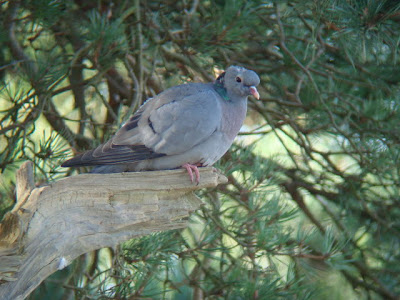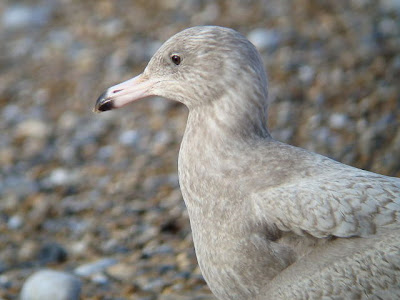Taken from the first hide looking out into The Wash, sat on the nearest in the line of wooden posts. Part of a good raptor day, which also produced a ringtail Hen Harrier and Peregrine over Ken Hill Wood, along with a rather respectable 9 Common Buzzards!

Common Snipe Titchwell Zoo
Stock Dove Dersingham Bog (Taken from the cliffs) A great place to watch this attractive, and often overlooked species.
Barn Owl Snettisham Coastal Park


Glaucous Gull Cley
Significantly better light, than the previous attempt, though wing now considerably drooped (primaries dragging along shingle)
Despite waiting at letheringset Ford for a total of just over 12 hours (7 consecutive hours one day, and another 5 two days later) the Black- bellied Dipper failed to make an apearance, despite me rejecting the nearby Cattle Egret (a would be Norfok tick) and staying put at the Ford just in case. I know which one I, and probably evereyone else, would have rather seen!
A productive morning at Wolferton, produced a flock of 22 Crossbills, and a singing Woodlark (always a delight to hear on a misty morning) as well as the wintering Great Great Shrike, which was seen distantly on a couple of occasions. Elsewhere a displaying Goshawk, was my first for about four years, and the hedges at Flitcham were positively brimming with Bramblings, with at least 60 birds, coming down to feed in the strips of planted Sorghum. A pair of Hawfinch were seen in their usual paddock at lynford Arboreutumn, and the Black necked Grebe showed well in the reedbed pool and dithes at Brancaster. A very good bird for the North Norfolk Coast.
Sunday was spent with Will Bowell, attempting to get as many of the local wintering species as time and light would allow. First stop was Sandringham, where two Woodcocks were watched in the headlights of the car (one of which was allready in the middle of the road, and approached to within 10 feet!) A Barn Owl, flying around the main car park, surrounded by trees, was something of an unexpected sight, but had its "odd factor" eclipsed by a male Sparrowhawk, sat on a molehill by the side of the road, lit up by the headlights, at a distance of about 15 feet! A Woodlark was singing on arrival at Dersingham, and the Great Grey Shrike was located at distance, whilst the only Buzzard of the day was seen from the cliffs, in fields behind Wolferton village. The hedges at Flitcham once again, held good numbers of Brambling, along with four Grey Partridge, and at least four Tree Sparrow, though the main target (Little Owl) kept itself hidden. A brief stop at Sculthorpe Mill quickly secured Grey Wagtail, with a bird waiting on the edge of the main river, whilst just along the road, Sculthorpe Moor produced Water Rail, Marsh Tits, the days only Bullfinch, and another 35 Brambling feeding around the bird table below the reedbed hide. Two Treecreepers also showed well in the trees behind the old visitor centre.
Having missed Nuthatch on the birdtable at Sandringham, and with time still on our side (35 minutes ahead of schedule), a quick stop in Holkham park was in order. With the target quickly located in the trees just the other side of the entrance gate, we managed to arrive at Lady Annes drive, 15 minutes ahead of time, despite taking in an additional and unscheduled stop! A group of 70 Snow Buntings were flying over the western end of the grazing marsh, whilst three Stonechat in the fields, by the eastern end of the pines, offered compensation for a lack of visible Short eared Owls. A power walking sprint to Washington hide, provided two quality ticks, with a large female Peregrine sat in one of the fields, and a group of just over a dozen White fronted Geese, out towards the back of the marsh. In addition, the days only Kestrel put in an appearance, whilst Egyptian Goose proved almost as tricky! Common Scoter and Rock Pipit were also added, on an equally fast paced dash back along the saltmarsh.
At Brancaster the Black necked Grebe showed well in the ditches below the bank, and a Spotted Redshank was in the main tidal channel. Further along the coast, and a short way inland, Chosely proved a slight return to form (no doubt helped by the conversion of processing grain, after using the barns for storing sugarbeet) with eight Corn Buntings and around 20 Yellowhammers coming down to feed around the concrete pad. Fulmars were present in good numbers at Hunstanton, and at least one Velvet Scoter was offshore, with a group of around 40 Commons. Spirits took something of a knock, when a search of the sea off of Gore point failed to add anything new, other than a single Grey Plover on the beach. Backtracking along the coast, Thornham Harbour failed to add the hoped for Lapland Bunting, but added Ruff, and Ringed Plover, as well as a single Fieldfare along the entrance road (our only one of the day!
Titchwell proved to be very quiet, with the only additions coming in the form of Avocet, Black tailed Godwit, Goldeneye, and Mediterranean Gull. A search of the sea was even more dissapointing, with nothing new added to the list. With news of a male Lapland Bunting showing well at Thornham, we left Titchwell with just enough light, only to miss out on the bird by about 10 minutes. Knot was finally added to the tally, whilst a walk along the footpath, at the back of the reedbed provided the final tick of the day, with a group of calling Beared Tit.
108 species in Total with the following "easier" species escaping detection...
Divers
Grey Heron
Eider
Long tailed Duck
Kittiwake
Auks
Little Owl
Redwing
Cettis Warbler
A great day out, with some unbeatable company... Cheers!























